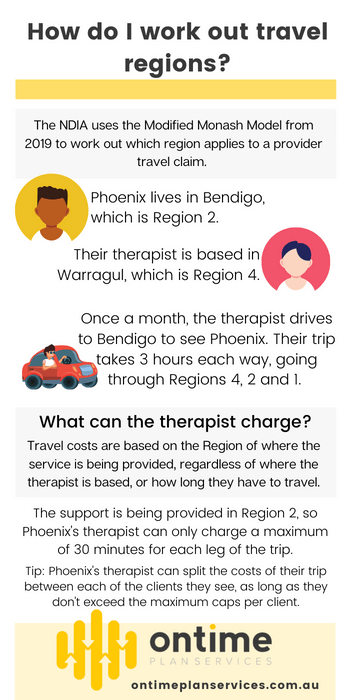The NDIS pays for a variety of transport options for participants and providers. Unfortunately, the use of the terms ‘travel’ and ‘transport’ can be confusing. Here in Part 2 we look at provider travel. We previously discussed transport payments in Part 1. Before we go any further – these rules and amounts change a LOT, so bear in mind when you’re reading this, that we last updated this article in October, 2022. Always follow the links and check the NDIS website for the latest rules and prices. Now, read on!
Travel explained

As a plan manager, our clients often ask us, “My provider has charged me for travel. Can they do that?”.
In brief, provider travel is anything but simple! The NDIA has rules about which support providers can charge travel, and is strict about where the supports are provided. Usually, providers can only charge for travel if:
- the provided support is face to face,
- the support is approved for provider travel in the NDIS price guide,
- the provider has explained their service and it’s value to the participant, and
- the specific travel costs have been explained, and agreed to in advance by the client. Ideally, this should be in the provider’s Service Agreement.
There’s a bit more to it than that, so if you’re a provider reading this, or just want to do a Deep Dive, we suggest you get the facts straight from the source – the NDIS “Pricing Arrangements and Price Limits” guide.
Provider travel can be charged in two parts
Time costs
Firstly, providers can claim the time to travel to a client, up to a maximum of:
- 30 minutes for supports delivered in a metropolitan or regional centre (MMM 1-3) or
- 60 minutes for a regional area (MMM 4-5).
The region code is based on the Modified Monash Model (2019 version). You can find an interactive guide here: https://www.health.gov.au/resources/apps-and-tools/health-workforce-locator/health-workforce-locator

The most important thing to remember is that the ‘region’ means where the support is being delivered, not where the provider comes from.
A recent price guide update allowed providers from both Core or Capacity Building supports to claim for ‘return travel’. Return travel is stated as being from a client back to the provider’s usual workplace or office. It can also be for travel from one client to another, such as when a provider is travelling around an area and seeing a list of clients. In this case, the NDIS says it is reasonable to apportion charges among the clients, as agreed to beforehand.
The time billed for the return trip cannot be more than the maximum billable caps as above. A provider bills this travel time at the same hourly rate (or lower) as the primary support and from the same funding category. This means your therapy funding is also used to pay for the provider’s travel, so bear that in mind when you’re working out how many hours of services you can afford.
Tip from a plan manager: When we receive an invoice for travel time from a provider, we don’t know how much time they actually took to get to you, or back to their office. So if you don’t want to be overcharged, make sure you discuss this with them beforehand, and then check your invoice that they have claimed the correct amount of time. If you’ve agreed to a 10 minute charge each way, and regularly get billed for 30 minutes each way, your funding will get chewed up very quickly!
Non-labour (vehicle) costs

Just like Activity Based Transport (see Part 1), providers can bill for costs they incur to provide supports at the participant’s location. These costs can include road tolls, parking fees, and the running costs of the vehicle. They can be billed to the client at what the NDIA considers “a reasonable contribution”. Once again, the NDIA suggests 97 cents per kilometre as reasonable, but does not state a capped maximum amount.
As we have said, a provider can only bill for travel if the Price Guide ruling allows for it. This doesn’t mean that a provider must charge for travel. For example, while garden services and house cleaners can charge for provider travel, not all of them will. After all, for these services, it would be easy to replace a high cost provider with someone cheaper. Not to mention that you could argue they are discriminating against someone with a disability by charging them more!
Just to confuse you further
What we’ve discussed above covers the majority of participants. As this is the NDIA however, it couldn’t possibly be that simple! There are other scenarios that you might stumble across, such as:
- one therapist traveling to see multiple clients in a region.
- participants living in remote (Region 6) or very remote regions (7), where different rules apply!
If you’ve got a question on these, it’s best to get in touch with us so we can help you in your specific circumstances. You can also find more information in the NDIS price guide. The latest guide is available here: https://www.ndis.gov.au/providers/price-guides-and-pricing. If you are wanting to do a very Deep Dive into this because you’re a provider, then we highly recommend heading over to the gurus at DSC, who have some excellent courses on all topics NDIS.
Summing it all up…
In a nutshell: Providers can charge for travel costs to provide their face-to-face service to you, as long as they have discussed fees with you beforehand, and follow NDIA price guide rules.


